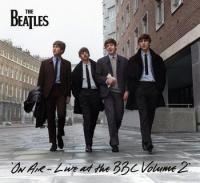The Beatles: "On Air-Live at The BBC Volume 2" A Fascinating, Musically Worthy Time Capsule
The time-capsule “banter” between the boys and the BBC hosts is in some ways as enjoyable as the music. In America, every city and every region had its own Top 40 music scene and star DJs. In New York, for instance, we had Alan Freed, Murray “The K” Kaufman (who billed himself as “the 5th Beatle”) and Cousin Brucie. They provided the connection between the band and the fans, inserting a level of “teen idol frenzy hype” that the on-air chats included here seem to indicate did not occur on the BBC air.
Between March 1962 and June of 1965, on various network programs, the BBC broadcast nationwide at least 275 Beatles performances. In 1963 alone the quartet performed on 39 radio shows. At the time, three BBC stations produced all of the UK’s daytime programming, with almost all of the aired music performed live and that included The Beatles, who used these live performances to promote their records.
“Everything was done instantly,” remembered George Harrison, “But before that, we used to drive 200 miles in an old van down the M1, come into London, try and find the BBC and then set up and do the program. Then we’d probably drive back to Newcastle for a gig in the evening!”
The show hosts, with their big, announcer-y voices occasionally condescend and often ask banal questions that the four could have easily mocked but given what they were doing there in the first place, they resisted.
In these interviews John, Paul, George and Ringo sound “local” even though they were being heard nationwide. Clearly the “zany mop-top” image many Americans had of them during those early years was created by and for the American market. Whatever outfits Brian Epstein put them in, and whatever image-making he did, The Beatles you hear in these BBC interviews, come across as serious young and very eloquent adults. Perhaps there serious tone is due in some part because of the BBC's then being such a venerated institution to which they all grew up listening.
Hearing John Lennon talk about his new-found wealth, his big home, his all-black Rolls-Royce and especially what sounds like a very non-celebrity, mundane daily existence despite the riches, fascinates in that he comes across as enjoying it but not being impressed by it or trying to flaunt it. Even at this early stage he voices the heavy burdens of fame.
All four of them come across as 100% genuine, down to earth guys not trying to impress their fans as anything but, which is in marked contrast to some of their early American press conference appearances, where there was more “wising off”, possibly in part because of the stupid questions asked by the teen-idol fixated American media— not that they aren’t also witty, irreverent and charming here too.
You may begin by thinking these interludes intrusive but as they continue you’ll appreciate their contextual value. As for the music, it’s live, it’s spontaneous, and it's not overdubbed. These guys could not only play as a tight ensemble, but they were able to spontaneously match levels to produce a wonderfully natural and balanced sound, even on the more primitively engineered tracks, of which there are but a few. You'll hear the familiar arrangements intensified by live take energy and spontaneity.
The perform hits like “I Saw Her Standing There,” “Twist And Shout,” “Do You Want To Know A Secret,” “Boys,” “Please Mister Postman,” “Money,” “And I Love Her,” and “If I Fell” as well as covers of tunes that influenced them not all of which were recorded and released on their Parlophone albums.
You can probably find the track list online so I’m not going to regurgitate it here. If you are a Beatles fan, you’re sure to welcome this addition to your collection. It presents them both as already skilled and serious musicians and as thoughtful articulate young adults anxious to jettison as early as possible the teen idol artifice and not worried about possible negative consequences.
Perhaps had we had access to these interviews back then, the leap from “Yeah, Yeah, Yeah”, to “Norwegian Wood” would have been less of a surprise and more of a natural and expected progression.
Paul McCartney talked about this just the other day on The Howard Stern Show. He said (and I’m paraphrasing) “If you look at the song titles, they were ‘I Want to Hold Your Hand’ and ‘From Me to You’ and Do You Want to Know a Secret?’ and ‘I’ll Get you’—it was all about singing directly to the fans. Then we began to just express ourselves for our needs.”
CD 1 ends with interview profiles of John and George. CD 2 ends with profiles of Paul and Ringo. As much as you’ll enjoy the music, after the profiles you’ll probably have a hard time deciding which you enjoyed more.
When I get the vinyl I’ll go into greater depth about the booklet, the packaging and sound but based on the CDs, the sound is variable in terms of source quality, with some of it excellent mono and some marginal, but all of it has been very well-mastered and even on CD much of it sounds vibrant and immediate as if you’re on the studio of the microphones.



